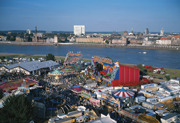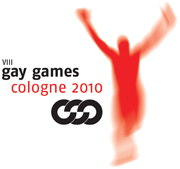Cologne & Düsseldorf … where Gay Games VIII is just the beginning

By Lawrence Ferber
COLOGNE
There’s a scent wafting about Cologne, Germany, and that’s the eau du homo! Germany’s fourth largest city is also the country’s second capital of gay life (and, timeline-wise, the first), with a diverse bevy of scenes, events, nightlife, culture and social outlets. Heck, Cologne even won the bid to host the upcoming Gay Games VIII, which take place July 31–August 7 (see sidebar).
Situated on the Rhine River, Cologne is best known for its iconic namesake Cathedral (the Kölnischer Dom) and Karneval (www.koelnerkarneval.de), a month’s-long wintertime party culminating in February that involves wacky costumes, Schlager (a genre of music), and nonstop consumption of Kölsch, the city’s beer of choice. FYI, German cities and their local brews are akin to American cities and their baseball teams—complete with fierce loyalties and rivalries.
Hotel Excelsior (www.excelsiorhotelernst.com) is magnificent, queer-friendly, and located right next to the cathedral and train station. It is a favorite of gays during July’s annual gay pride event (known in Germany as “Christopher Street Day” or CSD) and Karneval, with an awesome in-house French restaurant, Hanse Stube, and Japanese fusion venue Taku. If modern aesthetics give you wood, Hotel Im Wasserturm (www.hotel-im-wasserturm.de), a water tower turned luxury hotel, is tough to beat, and its Michelin star-winning La Vision is haute, haute, haute!
Begin with Museum Ludwig’s (www.museum-ludwig.de) collection of avant-garde and pop art. Walk downstairs to the Rhine’s bank (across the water you’ll spot the convention center area) to see the pink triangle-shaped memorial to the Nazis’ LGBT victims. Next, stroll along the Rhine toward the Deutzer Brucke bridge and find the cobblestoned AIDS Memorial, “Names and Stones,” upon which names of those we’ve lost—including Keith Haring and Klaus Nomi—are inscribed.
Next, stop at the glass-enclosed Choc- olate Museum (www.schokoladenmuseum.de), where you can see actual cocoa pods growing in a tiny simulated tropical environment, chocolates molded in a working mini-factory, and decades’ worth of paraphernalia and memorabilia. The museum’s gift shop is a must-see, with a dizzying array of products on offer. I highly recommend Coppeneur and Labooko brands, the latter for its unusual organic bars made with sheep’s, goat’s, and even horse’s milk.
About 92 percent of Cologne was destroyed during World War II. One structure that survived is the EL-DE Haus (Appellhofplatz 23-25). A former Gestapo headquarters, its basement served as a prison where the Nazis’ political enemies awaited execution, while the upper floors house exhibitions about the Third Reich’s rise and fall, from galling anti-Semitic propaganda to recorded testimonies from gay Holocaust survivors.
Named after the city, the original Eau de Cologne, created in the 18th century and known locally as Kölnisch Wasser, can be sniffed and purchased at shop 4711 (www.4711.com). The main shopping thoroughfares include Schildergasse—home of the visually striking, high-end fashionista department store, Peek & Cloppenburg (www.peekundkloppenburg.de), designed by architect Renzo Piano—Hohe Strasse, and the very hip Breite Strasse, with its loads of nifty book and fashion outlets. And don’t overlook the many cool, unique boutiques occupying the side-street nooks and crannies—for example, Honig Müngersdorf (www.honig-muengersdorff.de), dedicated to all things honey, from beer to gummy bears.
For the quintessential Kölsch beerhouse experience, the multi-level, always-crowded Früh (www.frueh.de) is the place. Sophisticated foodies should take a short trip outside the city to the three-Michelin star-winning Dieter Müller restaurant at the romantic, elegant Castle Hotel Lerbach (www.schlosshotel-lerbach.com) for French/Mediterranean/Asian fusion glory.
There are approximately 60 gay bars in Cologne, largely concentrated in two areas around Rudolfplatz (the “Bermuda Triangle”) and Old Town. You can find everything from glowing, modern, young hipster lounges like Ixbar (www.ixbar.de) and Marsil (Marsilstein 27) to primped teenager pop-playing faves like Die Mumu (www.die-mumu.de) to über-fetishy leather clubs with slings (but no arrows!) like Deck 5 (www.deck-5.de), Midnight Sun (www.midnight-koeln.de), and Station 2b (www.station2b.de).
Bears are huge in Cologne, literally and figuratively, with bars like Cox (www.cox-cologne.de) and international Bear events in spring and winter (see www.bearscologne.de and www.bearpride.de). Lesbians are in for a big, lively scene as well, with dedicated Pride events and bar/restaurants including Blue Lounge (blue-lounge.com) and Gezeiten (www.gezeiten-koeln.de).
Cologne’s tourism office (www.koelntoursmus.de/en) publishes the free Out in Cologne guide. German website www.inqueery.de is the place for gay party info in Cologne and other cities in the Rhineland and beyond. Also check free magazines/websites Blu (www.blu.fm), Exit (www.exitmagazin.de), and Box (www.box-online.de).
DÜSSELDORF
A half-hour from Cologne by train (you can use a German Rail Pass to go between the two: www.raileurope.com), Düsseldorf (www.duesseldorf-tourismus.de) has remained a little under the radar for U.S. tourists. Though much quieter on the gay nightlife front, but branding itself an “art city,” Düsseldorf is utterly vibrant. The breadth and uniqueness of its galleries is staggering. Its Art Academy produced Joseph Beuys, Gerhard Richter, and Andreas Gursky, and the Frank Gehry-designed cluster of buildings in its “media harbor” is simply marvelous.
Düsseldorf is host to numerous trade shows, including a Fashion Week, and one of the largest Japanese expat populations outside of Japan (approximately 7,000), so there are plenty of Japanese shops and restaurants. Alt is the local beer—ask for a Kölsch at your own risk!
Hotel Windsor (www.sir-astor.de) is a nicely located, gay-friendly B&B, while sister property Lady Astor adds a touch of avant-garde aesthetics. Inexpensive yet modern in design, German chain Motel One (www.motel-one.de) has a property here, or you can play Tokyo businessman at the Asahi (www.hotel-asahi.de).
Königsallee (the Kö), is one of Europe’s most luxurious boulevards, with shopping centers and a little bit of Champs-Elysées flava (www.koenigsallee-duesseldorf.de). During Karneval’s climactic Saturday, drag queens race down the Kö as an AIDS fundraiser (for the Heartbreaker organi-zation). One of the most amazing shopping centers is the design-centric Stilwerk (www.stilwerk.de), which seems straight out of Scandinavia. Be sure to stop in Heinemann’s (www.konditorei-heinemann.de) for their famous chocolates, pastries, and Champagne truffles. Old Town is flecked with smaller boutique businesses, like the amazing Düsseldorfer Senfladen (www.loewensenf-senfladen.de), which is dedicated to all things mustard.
Napoleon once dined in Old Town’s Zum Schiffen (www.brauerei-zum-schiffchen.de), and a bust commemorates where he sat. Try traditional local staples like Rheinische Sauerbraten (braised beef with raisins, almonds, and red cabbage) and Alt beer. The media harbor’s Meerbar (www.meerbar.de) is recommended for its cocktails and food, not to mention its trendy ambiance. Tucked away in a parking lot adjacent to a train station, the packed Bar Olio (Schirmerstraße 54) is a hot local secret featuring incredibly fresh, flavorful new German and international bistro fare blessed with aromatic herbs and produce—and the chef looks like Robbie Williams after a few years in the clink. Yummy!
Take in an aerial view of the media harbor and city from the Rhine Tower. Back on the ground, walk to the nearby glass and cement rectangle that serves as entry to KIT (www.kunst-im.tunnel.de), an underground, sloping space dedicated to young art. A very cool Sonic Youth exhibition was installed here during my trip. Next, check out the four-story Film Museum (www.duesseldorf.de/kultur/filmmuseum) for a journey through film’s past and present. Its costume gallery, which features one of Jean-Paul Gaultier’s amazing The Cook, the Thief, His Wife and Her Lover originals, is a real treat.
The K20 (under renovation and slated to re-open this year) houses big-name classical modernism and pop art, while the K21 (www.kunstsammlung.de) is all about contempo. Its glass-enclosed top level offers a bonus view of the city. Coolest and most unique of all is the Museum Insel Hombroich (www.inselhombroich.de), a series of concrete galleries scattered about a massive 200,000 square meters of meadowland. There are no security guards posted, allowing for intimate encounters with incredibly rare, diverse works from Picasso sketches to Chinese artifacts. For a full gallery and exhibition rundown, check www.artcity-duesseldorf.de.
Gay scene-wise, Aroma Cafe (www.aroma-duesseldorf.de) dishes up both daytime café fare and nighttime cocktails. Sister venue K1 (www.k1-duesseldorf.de) is a dance club that skews young. Café-Bar Piranha (www.cafepiranha.de) is largely lesbian but male-friendly. Wilma “Next Generation” (www.wilma-duesseldorf.de) is open until 5 a.m. Café Seitensprung (www.cafe-seitensprung.de) is a neighborhood bar and a bit hustler-y.
Lawrence Ferber is a frequent contributor to OutSmart magazine.











Comments